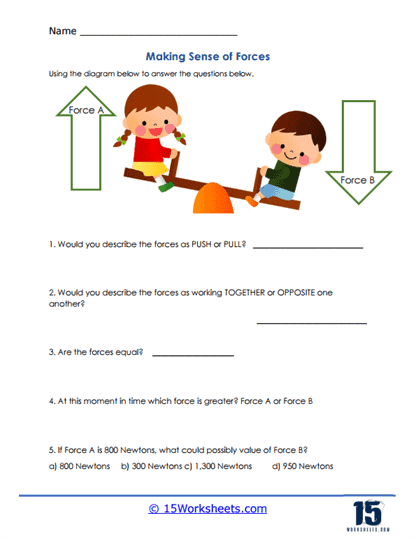Making Sense of Forces

Worksheet Description
The worksheet helps students begin to understand forces and their interactions using a straightforward illustration of two individuals applying distinct forces labeled as Force A and Force B. Through the depicted scenario, students are invited to identify the nature of the forces (whether they are push or pull), assess if the forces are working in congruence or in opposition, and deduce which of the forces exhibits a higher magnitude. Additionally, based on provided data about one of the forces, students are also tasked with predicting possible values for the other force, thereby practicing calculations associated with force magnitudes.
To proficiently tackle this worksheet, students should commence by scrutinizing the visual representation to determine the direction and nature of each force. By observing the orientation and position of the characters in relation to the forces, they can infer whether the forces are push or pull and discern if they act in unison or in opposition. Comparing the visual sizes of Force A and Force B will allow students to decide which force is more dominant at the depicted moment. For the final question, they should utilize the given value of Force A to estimate the plausible range for Force B’s magnitude.
The primary educational aim of this worksheet is to instill in students the foundational concepts of force dynamics in a tangible and engaging manner. By offering a real-world analogy, the worksheet emphasizes the different types of forces, their interplay, and the repercussions of unbalanced forces. It stimulates critical thinking, prompting students to deduce outcomes based on visual cues and to employ basic arithmetic to predict force magnitudes. Ultimately, the exercise seeks to familiarize students with the fundamentals of forces, preparing them for more advanced physics topics.
